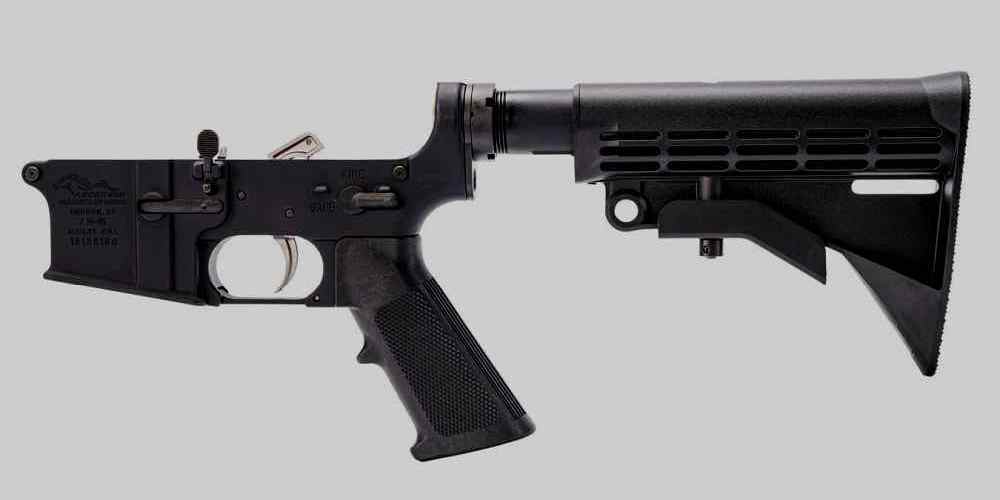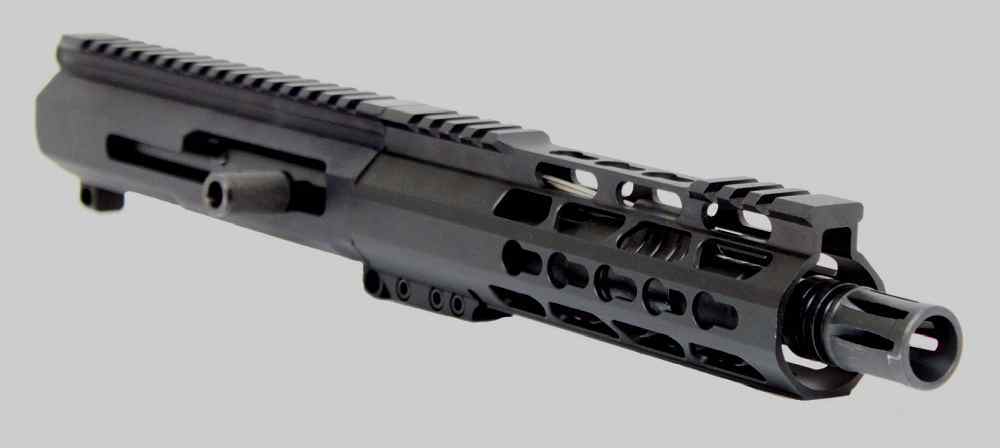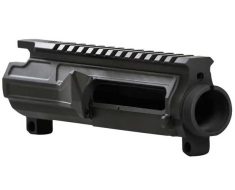“Secure your shot with a strong connection.”
Proper Installation Techniques for AR15 Upper Receiver and Barrel
When it comes to building or customizing your AR15 rifle, one of the most critical components to pay attention to is the connection between the upper receiver and barrel. Proper installation of these two parts is essential for ensuring the reliability and accuracy of your firearm. In this article, we will discuss the importance of the upper receiver and barrel connection, as well as provide you with some tips on how to install them correctly.
The upper receiver of an AR15 is the part of the rifle that houses the bolt carrier group, charging handle, and barrel. It is also where the handguard, optics, and other accessories are typically mounted. The barrel, on the other hand, is the component that actually fires the bullet and determines the accuracy and performance of the rifle. The connection between the upper receiver and barrel is crucial because any misalignment or improper installation can lead to malfunctions, poor accuracy, and even safety hazards.
When installing the barrel into the upper receiver, it is essential to ensure that the barrel extension is properly aligned with the upper receiver’s feed ramps. This alignment is crucial for reliable feeding and chambering of rounds. To achieve this, you should carefully slide the barrel into the upper receiver, making sure that the barrel extension lines up with the feed ramps. You may need to wiggle the barrel slightly to get it to seat properly.
Once the barrel is in place, you should tighten the barrel nut to secure the barrel to the upper receiver. The barrel nut is a critical component that holds the barrel in place and provides stability and alignment. It is essential to torque the barrel nut to the manufacturer’s specifications using a torque wrench. Over-tightening or under-tightening the barrel nut can lead to issues such as barrel misalignment, poor accuracy, and even damage to the rifle.
After securing the barrel nut, you should install the gas block and gas tube. The gas block is responsible for directing gas from the fired round back into the rifle’s action to cycle the bolt carrier group. It is crucial to ensure that the gas block is properly aligned with the gas port on the barrel to prevent gas leaks and cycling issues. The gas tube should be inserted into the gas block and secured with a roll pin.
Once the gas block and gas tube are in place, you can install the handguard, optics, and other accessories onto the upper receiver. It is essential to ensure that these components are properly aligned and securely mounted to prevent any movement or shifting during use.
In conclusion, the connection between the upper receiver and barrel of an AR15 is a critical aspect of the rifle’s performance and reliability. Proper installation of these components is essential for ensuring accurate and safe operation. By following the tips outlined in this article, you can ensure that your AR15 upper receiver and barrel are installed correctly and function optimally. Remember to always refer to the manufacturer’s instructions and specifications when installing or customizing your rifle.
Benefits of a Tight and Secure Connection Between Upper Receiver and Barrel
When it comes to building or customizing an AR15 rifle, one of the most critical components to consider is the connection between the upper receiver and barrel. This connection plays a crucial role in the overall performance and accuracy of the firearm. A tight and secure connection between the upper receiver and barrel is essential for ensuring consistent and reliable shooting.

One of the primary benefits of having a tight and secure connection between the upper receiver and barrel is improved accuracy. When the two components are properly aligned and securely fastened together, there is minimal movement or play between them. This stability helps to maintain the alignment of the barrel, ensuring that each shot is fired in the same direction. As a result, shooters can expect more consistent and precise shot placement.
In addition to improved accuracy, a tight connection between the upper receiver and barrel also helps to enhance the overall reliability of the firearm. A loose or poorly fitted connection can lead to malfunctions and misfires, which can be frustrating and potentially dangerous. By ensuring that the upper receiver and barrel are securely fastened together, shooters can minimize the risk of these issues and enjoy a more reliable shooting experience.
Another benefit of a tight and secure connection between the upper receiver and barrel is increased durability. When the two components are properly aligned and fastened together, they are better able to withstand the recoil and stress of firing. This can help to extend the lifespan of the firearm and reduce the likelihood of damage or wear over time. By investing in a high-quality upper receiver and barrel with a secure connection, shooters can enjoy a more durable and long-lasting firearm.
Furthermore, a tight connection between the upper receiver and barrel can also help to improve the overall feel and handling of the firearm. When the two components are securely fastened together, there is less movement and play, resulting in a more solid and stable shooting platform. This can help shooters to maintain better control over the firearm and achieve more consistent and comfortable shooting.
Overall, the benefits of a tight and secure connection between the upper receiver and barrel are clear. Improved accuracy, reliability, durability, and handling are just a few of the advantages that shooters can expect when investing in a high-quality upper receiver and barrel with a secure connection. By taking the time to ensure that these components are properly aligned and fastened together, shooters can enjoy a more consistent and enjoyable shooting experience.
In conclusion, the connection between the upper receiver and barrel is a critical component of an AR15 rifle. A tight and secure connection between these two components can lead to improved accuracy, reliability, durability, and handling. By investing in a high-quality upper receiver and barrel with a secure connection, shooters can enjoy a more consistent and enjoyable shooting experience. So, whether you are building a new rifle or customizing an existing one, be sure to pay close attention to the connection between the upper receiver and barrel. Your shooting performance will thank you.
Common Issues with AR15 Upper Receiver and Barrel Connection
The AR15 upper receiver and barrel connection is a critical component of the rifle that can sometimes present challenges for gun owners. Understanding the common issues that can arise with this connection is essential for maintaining the functionality and accuracy of your firearm.
One of the most common issues with the AR15 upper receiver and barrel connection is a loose fit. This can occur due to a variety of factors, including improper installation, wear and tear, or poor quality components. A loose connection can lead to decreased accuracy and reliability, as well as potential safety hazards.
To address a loose fit between the upper receiver and barrel, it is important to first ensure that the components are properly aligned and seated. This may require disassembling the rifle and reassembling it with care to ensure a snug fit. Additionally, using high-quality components and regularly inspecting the connection for signs of wear can help prevent this issue from occurring in the future.
Another common issue with the AR15 upper receiver and barrel connection is barrel nut misalignment. This can occur when the barrel nut is not properly tightened or when the threads are damaged. A misaligned barrel nut can cause the barrel to shift during firing, leading to decreased accuracy and potential malfunctions.
To address barrel nut misalignment, it is important to carefully inspect the threads and ensure that the nut is properly tightened. If the threads are damaged, it may be necessary to replace the barrel nut to ensure a secure connection. Regularly checking the tightness of the barrel nut and addressing any issues promptly can help prevent this issue from affecting the performance of your rifle.
In addition to loose fits and barrel nut misalignment, another common issue with the AR15 upper receiver and barrel connection is gas system problems. The gas system is responsible for cycling the action of the rifle and can be affected by issues with the connection between the upper receiver and barrel.
If you are experiencing gas system problems, it is important to first check the alignment of the gas block and gas tube. Ensuring that these components are properly aligned and secured can help prevent issues with gas flow and cycling. Additionally, regularly cleaning and maintaining the gas system can help prevent buildup and blockages that can affect its performance.
Overall, understanding the common issues that can arise with the AR15 upper receiver and barrel connection is essential for maintaining the functionality and accuracy of your rifle. By addressing loose fits, barrel nut misalignment, and gas system problems promptly and effectively, you can ensure that your firearm performs reliably and safely. Regularly inspecting and maintaining the connection between the upper receiver and barrel can help prevent these issues from occurring and keep your AR15 in top condition for years to come.
Upgrading Your AR15 Upper Receiver and Barrel Connection for Improved Performance
If you’re looking to upgrade your AR15 rifle for improved performance, one area you may want to focus on is the upper receiver and barrel connection. This crucial connection plays a significant role in the overall accuracy and reliability of your firearm. Understanding how this connection works and what options are available for upgrading can help you make informed decisions to enhance your shooting experience.
The upper receiver of an AR15 is the part of the rifle that houses the bolt carrier group, charging handle, and barrel. It is responsible for housing and protecting these critical components while also providing a mounting point for accessories such as optics and handguards. The barrel, on the other hand, is the part of the rifle that guides the projectile as it exits the firearm, determining factors such as accuracy, range, and velocity.
The connection between the upper receiver and barrel is typically achieved through a barrel nut and a barrel extension. The barrel nut is a threaded ring that secures the barrel to the upper receiver, while the barrel extension is a cylindrical piece that fits into the upper receiver and locks the barrel in place. This connection must be tight and secure to ensure consistent accuracy and reliability.
One option for upgrading the upper receiver and barrel connection is to invest in a free-floating handguard. Free-floating handguards do not make contact with the barrel, allowing it to vibrate freely during firing. This can result in improved accuracy as the barrel is not influenced by external forces such as pressure from the handguard. Free-floating handguards also provide additional mounting points for accessories, allowing you to customize your rifle to suit your needs.
Another option for upgrading the upper receiver and barrel connection is to invest in a precision-machined barrel nut. Precision-machined barrel nuts are designed to provide a tighter and more secure connection between the barrel and upper receiver, reducing the chances of barrel movement during firing. This can result in improved accuracy and consistency, especially when shooting at longer ranges.
When upgrading your AR15 upper receiver and barrel connection, it is essential to consider factors such as compatibility, quality, and budget. Not all aftermarket parts are compatible with every AR15 rifle, so be sure to do your research and consult with a knowledgeable gunsmith if necessary. Additionally, investing in high-quality components will ensure that your rifle performs reliably and accurately for years to come.
In conclusion, upgrading your AR15 upper receiver and barrel connection can have a significant impact on the performance of your rifle. By investing in components such as free-floating handguards and precision-machined barrel nuts, you can improve accuracy, reliability, and customization options for your firearm. Remember to consider factors such as compatibility, quality, and budget when making upgrades, and consult with a professional if needed. With the right upgrades, you can take your shooting experience to the next level.
Importance of Regular Maintenance and Inspection for AR15 Upper Receiver and Barrel Connection
The AR15 upper receiver and barrel connection is a critical component of the firearm that must be properly maintained and inspected regularly to ensure optimal performance and safety. The upper receiver houses the bolt carrier group, charging handle, and barrel, while the barrel is responsible for directing the projectile towards the target. The connection between the upper receiver and barrel must be secure to prevent malfunctions and potential safety hazards.
Regular maintenance and inspection of the AR15 upper receiver and barrel connection is essential to ensure that the firearm functions properly and safely. Over time, carbon buildup, fouling, and wear and tear can affect the connection between the upper receiver and barrel, leading to decreased accuracy and reliability. By regularly cleaning and inspecting the upper receiver and barrel connection, you can identify and address any issues before they become serious problems.
To properly maintain the AR15 upper receiver and barrel connection, you should first ensure that the firearm is unloaded and the magazine is removed. Next, disassemble the upper receiver from the lower receiver and remove the bolt carrier group and charging handle. Inspect the upper receiver and barrel for any signs of wear, damage, or corrosion. Clean the upper receiver and barrel with a solvent and brush to remove any carbon buildup or fouling.
After cleaning the upper receiver and barrel, inspect the connection between the two components for any signs of looseness or misalignment. The barrel should be securely attached to the upper receiver with no play or movement. If you notice any issues with the connection, you may need to tighten the barrel nut or replace any worn or damaged components.
In addition to regular maintenance, it is important to inspect the AR15 upper receiver and barrel connection before each use. Check for any signs of wear, damage, or corrosion that may affect the performance of the firearm. Ensure that the barrel is properly aligned with the upper receiver and that all components are securely attached.
By properly maintaining and inspecting the AR15 upper receiver and barrel connection, you can ensure that your firearm functions reliably and safely. Neglecting to clean and inspect the upper receiver and barrel connection can lead to malfunctions, decreased accuracy, and potential safety hazards. Take the time to properly care for your AR15 to ensure that it performs at its best when you need it most.
In conclusion, the AR15 upper receiver and barrel connection is a critical component of the firearm that must be properly maintained and inspected regularly. By cleaning and inspecting the upper receiver and barrel connection, you can identify and address any issues before they become serious problems. Take the time to care for your AR15 to ensure that it functions reliably and safely every time you use it.






